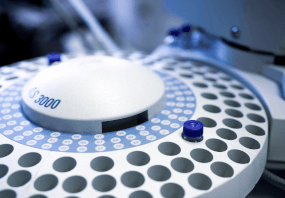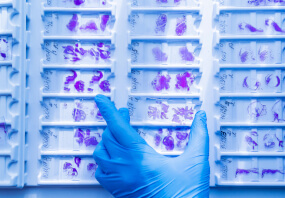General description
STAT proteins (Signal Transduction and Activators of Transcription) are latent cytoplasmic transcription factors that have the dual function of signal transduction and activation of transcription. STATs are activated by tyrosine phosphorylation in response to different ligands, after which they translocate to the cell nucleus. The N-terminal region is highly homologous among the STAT proteins and surrounds a completely conserved arginine residue. STATs are a part of the JAK-STAT signaling pathway – a major pathway of the immune system. All cytokines transduce critical signals through this pathway. STAT 1, is activated by a number of different ligands, including IFNalpha, IFNgamma, EGF, PDGF and IL6. Phosphorylation of tyrosine 701 is required for STAT 1 dissociation from IFNGR1, homodimerization, and nuclear translocation. Tyrosine 701 phosphorylation impairment results in loss of STAT 1 functions.
Specificity
Other species cross-reactivity is unknown.
Phosphorylated STAT1
Immunogen
Epitope: Tyr701
KLH-conjugated synthetic peptide (C-DDPKRTG[pY]IKTE) corresponding to amino acids 694-705 of mouse STAT1, containing a N-terminal cysteine.
Application
Anti-phospho-STAT1 (Tyr701) Antibody is a Rabbit Polyclonal Antibody for detection of phospho-STAT1 (Tyr701) also known as Transcription factor ISGF-3 components p91/p84 & has been validated in WB.
Research Category
Epigenetics & Nuclear Function
Research Sub Category
Transcription Factors
Quality
Routinely evaluated by immunoblot in RIPA lysates from CNTF-treated SK-N-MC cells.
Western Blot Analysis:
A 1:500-1:2000 dilution of this lot detected phosphorylated STAT1 in RIPA lysates from CNTF-treated SK-N-MC cells.
Target description
92 kDa
Physical form
Immunoaffinity Chromatography
Immunoaffinity purified IgG in 0.02 M PBS containing 0.1% Sodium Azide + 50% Glycerol and 5 mg/mL BSA.
Storage and Stability
Stable for 1 year at -20°C from date of receipt.
Handling Recommendations: Upon receipt, and prior to removing the cap, centrifuge the vial and gently mix the solution. Aliquot into microcentrifuge tubes and store at -20°C. Avoid repeated freeze/thaw cycles, which may damage IgG and affect product performance. Note: Variability in freezer temperatures below -20°C may cause glycerol-containing solutions to become frozen during storage.
Analysis Note
Control
Mouse 3T3-L1 adipocytes stimulated with leukemia inhibitory factor (LIF).
Other Notes
Concentration: Please refer to the Certificate of Analysis for the lot-specific concentration.
Legal Information
UPSTATE is a registered trademark of Merck KGaA, Darmstadt, Germany
Disclaimer
Unless otherwise stated in our catalog or other company documentation accompanying the product(s), our products are intended for research use only and are not to be used for any other purpose, which includes but is not limited to, unauthorized commercial uses, in vitro diagnostic uses, ex vivo or in vivo therapeutic uses or any type of consumption or application to humans or animals.
Shipping Information:
Dry Ice Surcharge & Ice Pack Shipments: $40
More Information: https://cenmed.com/shipping-returns
- UPC:
- 51314356
- Condition:
- New
- Availability:
- 3-5 Days
- Weight:
- 1.00 Ounces
- HazmatClass:
- No
- MPN:
- 07-307
- Temperature Control Device:
- Yes












